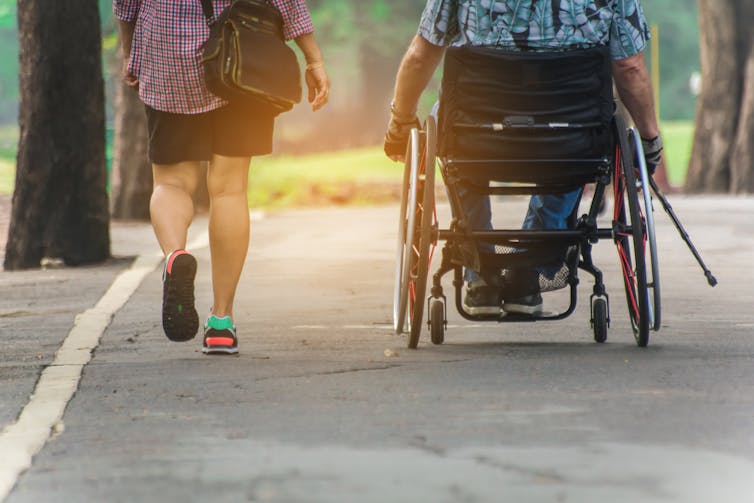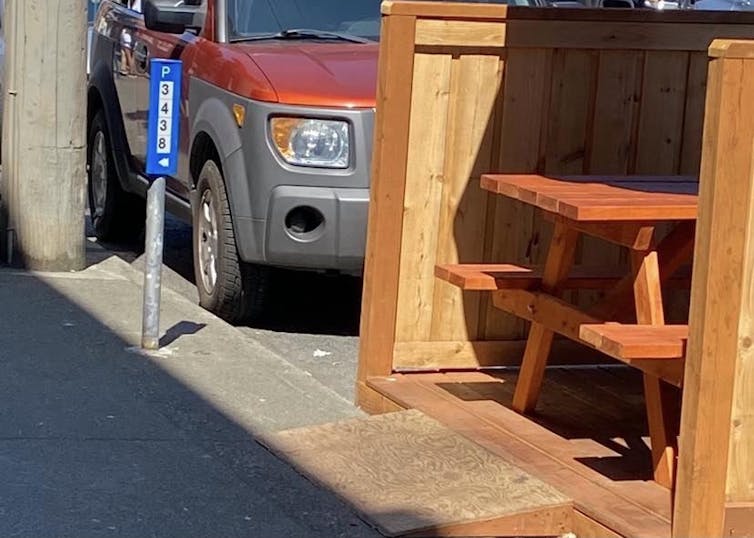
, ; , , and ,
The COVID-19 pandemic has highlighted the and how they fare in terms of walkability and wheelability.
Neighbourhood walkability and wheelability are defined as the “.” Very walkable and wheelable neighbourhoods have , or human-made surroundings, that .
that characterize walkable and wheelable neighbourhoods can include sidewalks, curb cuts and pedestrian traffic signals. When appropriately constructed, these features can and in many cases, neighbourhoods that are designed with this in mind are good for everyone.
Unfortunately, most neighbourhood built environments are . They can in fact create exclusionary environments for people with disabilities and older adults.
The pandemic brings into focus neighbourhood walkability and wheelability by highlighting persistent inaccessibility issues. It also creates the opportunity to advocate for change and bring about rapid and innovative solutions.
Barriers and facilitators to mobility
As neighbourhood walkability and wheelability are impacted by the built environment, poorly maintained and constructed neighbourhoods can create .
These barriers — like the condition of streets, sidewalks and crosswalks — can impact anyone but . Research finds that when streets are in even slight disrepair, people with severe mobility impairments are to report difficulty walking compared to those living in “good” neighbourhoods (neighbourhoods without cracks in sidewalks and potholes). Even slightly increasing the quality of streets could help people both access and remain involved in their communities.

Simple measures, such as involving people with disabilities in research and planning, are found to create targeted solutions to barriers and enhance the accessibility of neighbourhoods.
In the past, there were to have their opinions heard. With the recent rise of participatory research methods, however, they are increasingly working as “.” This helps create opportunities for collaboration with municipal officials and community service providers.
The shift towards participatory research moves us away from only researchers collecting data. Innovative data collection methods, , champion this shift. They help capture the users’ perspective and provide a more holistic understanding of environmental features affecting walkability and wheelability.
Overlooked accessibility and COVID-19
Neighbourhood built environments create barriers to inclusion that have been .
For example, added challenges that have arisen in response to the pandemic can include communication difficulties for those who are deaf and hard of hearing caused by , inaccessibility of hand hygiene products for mobility device users and increased navigational barriers like those from .
As the pandemic draws on, it has become glaringly clear that people living with disabilities have been . By and large, these strategies were intended to help us but they bring into focus our habitual pattern of overlooking accessibility and not consulting those with lived experiences.
A historical opportunity to advocate for change
Canada is at a historical crossroads to becoming barrier-free. The recent ushering in of accessibility acts, at , is creating the necessary infrastructure to enforce the creation of accessible built environments and the equitable inclusion of people with disabilities.
Post-pandemic recovery presents an as barriers have been exposed and the need to involve those with experience in creating solutions has been reinforced.
The alignment of research, public and political will and the pandemic-era realization that radical and rapid social change is possible creates the perfect conditions to create a Canada that provides access for all.
Alison F. Chung is a research assistant at ����AV and co-authored this article. She is working with the authors on a project titled: Towards Barrier-Free Communities: A Partnership for Improving Mobility, Access and Participation (MAP) Among People with Disabilities.![]()
, PhD Student, ; , Associate professor, Gerontology Department, , and , Graduate Research Assistant,
This article is republished from under a Creative Commons license. Read the .

